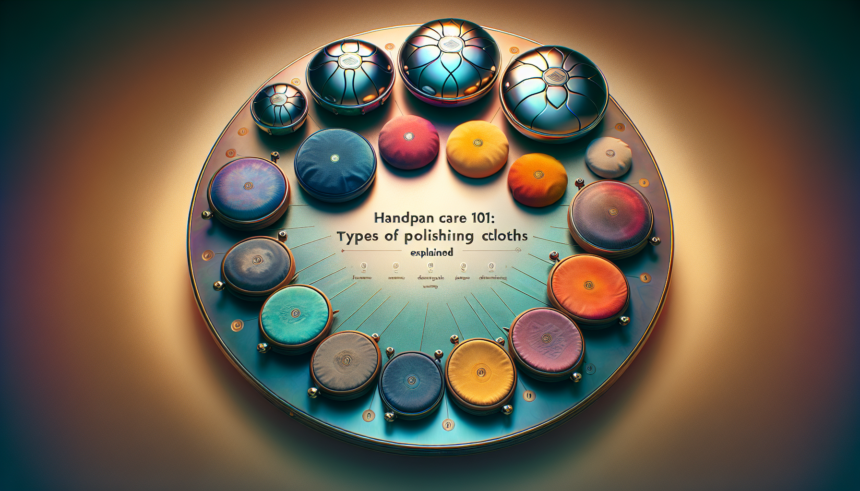The handpan, a beautifully crafted, melodic percussion instrument, has gained immense popularity among musicians and enthusiasts worldwide. To maintain its sublime sound and appearance, proper care and maintenance are essential. One critical aspect of handpan care is the cleaning and polishing process. Polishing cloths are indispensable tools for this task, but not all cloths are created equal. In this article, we will delve into the different types of polishing cloths available for handpan maintenance, their uses, and how to choose the right one for your instrument.
Microfiber Cloths
Microfiber cloths are a popular choice for handpan cleaning and polishing. They are made from synthetic fibers that are finer than silk, allowing for a gentle yet effective cleaning process. Here are some of the advantages of using microfiber cloths:
- Non-abrasive: Microfiber fabric is soft and does not scratch the delicate surface of the handpan, making it safe for regular use.
- Highly absorbent: These cloths are excellent at absorbing oils, dust, and residues without the need for additional cleaning agents.
- Reusable: Microfiber cloths can be washed and reused multiple times, offering an eco-friendly and cost-effective cleaning solution.
When using a microfiber cloth, ensure it is clean and free of any debris that could potentially scratch the handpan surface. Gently wipe the instrument in circular motions to remove dust and fingerprints.
Cotton Cloths
Cotton cloths are another common option for handpan care. These cloths are made from natural fibers and tend to be more affordable and accessible. Key benefits of cotton cloths include:
- Soft texture: Like microfiber, cotton is gentle on the handpan’s surface, preventing scratches and damage.
- Breathable material: Cotton allows air to pass through, which is beneficial when polishing with oils or other cleaning agents.
- Easy availability: Cotton cloths can be found in most households or purchased inexpensively, making them a convenient choice.
However, cotton cloths may not be as effective at removing fine dust and oil residues compared to microfiber cloths. Regular washing and replacement are also necessary to maintain their effectiveness.
Silk Cloths
Silk cloths, though less commonly used, offer a luxurious option for handpan care. The natural silk fibers provide a smooth and gentle polishing experience. Advantages include:
- Superior smoothness: Silk is incredibly gentle on the surface, ensuring a scratch-free polish.
- Effective polishing: Silk cloths can help achieve a high shine, enhancing the instrument’s aesthetic appeal.
- Hypoallergenic properties: Silk is naturally hypoallergenic, making it suitable for individuals with sensitive skin or allergies.
Silk cloths are often more expensive and may require special care, such as hand-washing and air-drying, to maintain their quality.
Chamois Leather Cloths
Chamois leather, derived from the hide of a chamois (a type of mountain goat), is renowned for its durability and absorbency. Chamois cloths are effective for more intensive handpan cleaning tasks. Key benefits include:
- High absorbency: Chamois leather can absorb a significant amount of moisture and oils, making it ideal for removing stubborn residues.
- Long-lasting: Chamois cloths are durable and can withstand extensive use over time.
- Non-abrasive: Despite its toughness, chamois leather remains gentle on the handpan surface.
To use a chamois cloth, wet it slightly and wring out the excess water. Gently wipe the handpan in a circular motion to clean and polish. It is important to periodically rinse the cloth and allow it to air dry to prevent mold and mildew growth.
Lint-Free Cloths
Lint-free cloths are specifically designed to prevent lint and fibers from being left behind during the cleaning process. These cloths are made from tightly woven materials and are particularly useful for maintaining a pristine finish. Their benefits include:
- No lint residue: Lint-free cloths ensure that no fibers are left on the handpan surface, providing a spotless finish.
- Versatility: They can be used with or without cleaning agents, making them adaptable to different cleaning needs.
- Gentle on surfaces: Lint-free cloths are soft and prevent scratches, ensuring the handpan remains in top condition.
These cloths are particularly useful when polishing with oils or other substances, as they prevent contamination and ensure a clean, polished finish.
Tips for Maintaining Polishing Cloths
To ensure the longevity and effectiveness of your polishing cloths, follow these maintenance tips:
- Wash regularly: Clean your cloths frequently to remove dirt, oils, and residues that can accumulate over time.
- Avoid fabric softeners: Fabric softeners can leave residues on the cloth that may transfer to the handpan, so avoid using them when washing your cloths.
- Store properly: Keep your polishing cloths in a clean, dry place to prevent contamination and mildew growth.
- Use dedicated cloths: Have separate cloths for different cleaning tasks to prevent cross-contamination and ensure optimal results.
Conclusion
Proper handpan care is essential to maintain its beautiful sound and appearance. Choosing the right polishing cloth can make a significant difference in the cleaning and maintenance process. Whether you opt for microfiber, cotton, silk, chamois leather, or lint-free cloths, each type offers unique benefits tailored to different cleaning needs. By understanding the characteristics and uses of these cloths, you can keep your handpan in pristine condition and enjoy its melodious sounds for years to come.
FAQs
1. How often should I clean my handpan?
It is recommended to clean your handpan regularly, ideally after each use. This helps prevent the accumulation of oils, dust, and residues that can affect its sound and appearance. A quick wipe with a microfiber or lint-free cloth is often sufficient for daily maintenance.
2. Can I use household cleaning products on my handpan?
It is generally advised to avoid using household cleaning products on your handpan, as they can contain harsh chemicals that may damage the instrument’s surface. Stick to specialized handpan cleaning oils or simply use water and a gentle cloth for cleaning.
3. How can I remove fingerprints from my handpan?
Fingerprints can be easily removed using a soft, dry microfiber cloth. Gently wipe the surface in circular motions to lift the oils. For more stubborn fingerprints, you may use a small amount of handpan cleaning oil on the cloth.
4. Are there specific cloths for different types of handpan finishes?
Yes, different handpan finishes may require specific types of cloths. For example, a nitride-coated handpan may benefit from a microfiber cloth, while a raw steel handpan might require a chamois leather cloth to remove rust and oxidation. Always check the manufacturer’s recommendations for the best care practices for your specific handpan finish.
5. How do I know when it’s time to replace my polishing cloth?
If your polishing cloth becomes overly soiled, worn out, or starts leaving lint and residues on the handpan surface, it’s time to replace it. Regularly washing your cloths can extend their lifespan, but eventually, they will need to be replaced to ensure effective cleaning and polishing.





